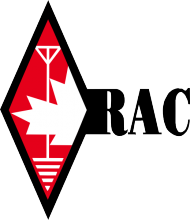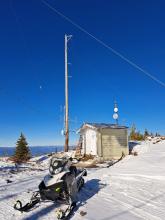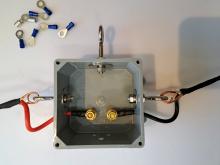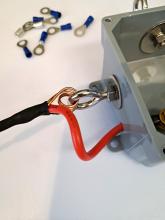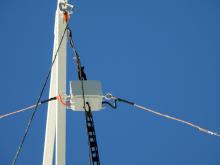Main menu
You are here
The HF Remote Station is back on the air!
On February 16-17 Myles, VE7FSR made trips by snowmobile up to Mt. Lolo to attempt to get the club's HF remote station back on the air. This required the "removal" of the PVC supports (aka stand-offs) that Ralph VA7VZA and Myles had installed late last fall to keep the ladderline from getting tangled in the steel foot pegs on the wood pole. Unfortunately when Myles came up with the "bright" idea of using the PVC supports he didn't think about how to lower the dipole without having to climb the pole again! Doh! Climbing the pole in winter was determined to be a non-starter -- getting the safety gear, ladder, and support crew up to Lolo in winter was nearly impossible. So this lead to a rather creative solution that involved using a slingshot to hurl a lead weight over the top-most PVC support, and then progressively larger lines and finally a rope was looped over the highest stand-off. The rope was hauled down until the PVC snapped off the pole, and the process was repeated until all the stand-offs were gone.
Then the dipole could be lowered in preparation for the installation of the new, improved centre insulator. The new centre insulator was made from a waterproof Carlon 4x4x2 inch electrical box, 1/4-inch stainless eye bolts, and brass machine screws.
To help reduce the strain on the copperweld wire at the insulator, a set of doubled-up copperweld wires was looped around the eye bolts, and these were electrically connected to the ladderline with 10g silicon jacketed, tinned copper wire. Hopefully the new centre insulator will be much more resistant to flexing in the wind, and will last a lot longer!To support the ladderline dacron rope was weaved through the "windows" of the ladderline, and thie was tied off to the Carlon electrical box at the top, and to the eye bolt in the building at the bottom. This seems like it will help support the ladderline in the wind (and boy was it windy on the Saturday!) and keep it from getting tangled on the steps on the wood pole. Unfortunately, when Myles hauled the broken antenna elements out from under the ice crust and snow, one of the dipole elements snapped. Not having any new copperweld with him (doh!) Myles decided to call it a day and come back the following day with some new copperweld dipole elements.
Day two was sunny, but the wind was crazy! This made finishing the dipole repair challenging, and the wind required careful effort to avoid having the dipole legs getting tangled in the various guy wires and trees. After several hours of (painful and slow) work, the HF dipole was back in the air, and ready for an SWR test. Myles then fired up the remote HF station computer and the IC-7300 radio, and proceeded to test the antenna SWR from 160M to 10M. The Icom remote tuner was able to find a match on all bands, which was great! Myles then made some contacts on several bands and asked for signal reports to confirm that the repaired antenna was working well. Once he was sure that the antenna was working, he restarted the Icom RS-BA1 software and tested the operation of the remote HF station (it verks!). Success!To see all the photos from the two-day repair expedition, please see: https://karc.ca/node/774


